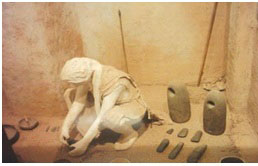(ST) – Archaeological Tel Bokross Hill in the city of Deir –Ezzour represents a model for the first farming village that was built by a unified plandates back to the Stone Age where houses were in close contact to each other and form one row on either side of the road and the village square.
“The archaeological researcher, Yaroub al –Abdullah, pointed out that the village dates back to 5900 BC. The number of the discovered houses reached to 188, and every house includes three long rooms built from dried adobes, the floors and walls were painted with mud or plaster.
Some of the walls were decorated with colorful frescoes; most of the drawings were geese and ducks. Those are the only discovered antiquities in the Middle Euphrates basin that belongs to the period of the Neolithic era,”Mr. al –Abdullah pointed out.
“Tel Bokross was an agricultural society that collected between agriculture and animal husbandry. Remains of charred plants reserved in the louvers of plaster inside some of the rooms were found at the site.
Studies indicated that barley was growing naturally in the Euphrates region,” Mr. al –Abdullah added.
“The residents of Tel Bokross excelled also in the field of handicrafts through the use of available raw materials in their surroundings such as ‘alabaster’, a harsh stone, which was used in the manufacture of pots, pointing out that what surprised the explorers is to find “needles” and “drills” made of the ‘Obsidian’ rock. Mr. al Abdullah noted.
It is a volcanic black transparent greenish rock. Currently, glass is made of this rock. This kind of rock is found only in the regions of Anatolia. This indicates that man in this region used the beasts and horses as a means to move to remote areas and it is a sign to early trade with remote areas,” Mr. al Abdullah clarified.
“Excavations carried out by the Dutch Archaeological Mission in 1976 in Tel Bokross resulted in the discovery of a large group of the of simple stone finds and statues in addition to documenting 1600 archaeological finds mostly are pots made of flint.
A wide range of unparalleled stone vessels also were found includingtools and drills made of rocks that used in hollowing these pots out,” Mr. al Abdullah said.
“The most important archaeological finds were a statue of a naked woman and a statue of a man’s head made strictly from grilled mud in addition to drills and awls made of flint, polished axes and tools of harsh rocks.
The archaeological mission also found an inscription on a millstone for a speckled and perforated tiger with a human head, weaving tools made of basalt, varied beads and dolls of mud and others of bone and statues of some animals such as a rabbit, tortoise and the head of a bull and other archaeological finds,” Mr. al -Abdullah explained.
All archaeological assets in Tel Bokross give a complete idea of a unique farming village that boomed in the region of the middle Euphrates basin and it is the first discovered agricultural village, Mr. al Abdullah concluded.
Sh. Kh.

